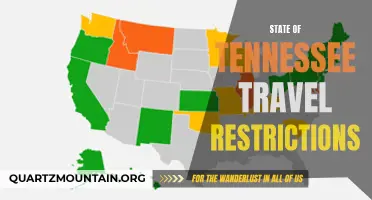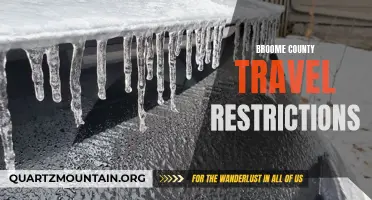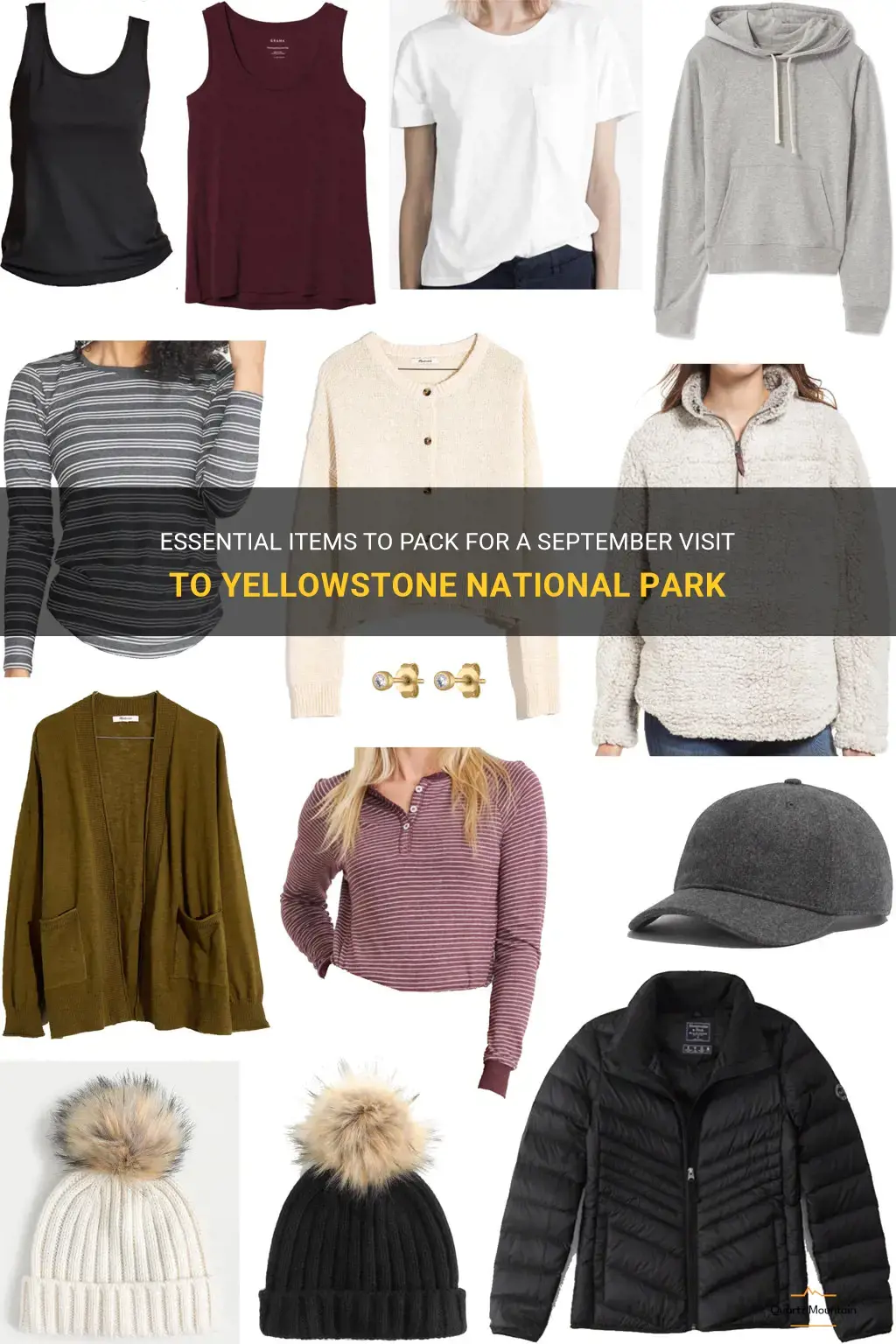
Are you planning a September visit to Yellowstone National Park? As summer gives way to fall and the park's vibrant landscapes begin to change, it's important to pack the essential items that will make your trip comfortable and enjoyable. From warm clothing to bear spray and hiking boots, we'll guide you through the must-have items for your September adventure in Yellowstone National Park.
| Characteristics | Values |
|---|---|
| Weather | Mild to cool |
| Temperature | 28-69°F |
| Rainfall | 1-2 inches |
| Clothing | Layered |
| Footwear | Comfortable |
| Accessories | Hat, sunglasses, sunscreen |
| Insect repellent | Recommended |
| Camping gear | Tent, sleeping bag, camping stove |
| Hiking gear | Backpack, hiking boots, water bottle |
| Wildlife | Bears, elk, wolves, bison |
| Fishing gear | Rod, reel, fishing license |
| Binoculars | Recommended |
| Camera | Recommended |
| Medication | Personal medication, first aid kit |
| Food | Non-perishable and easy to cook options |
What You'll Learn
- What type of clothing should I pack for a September trip to Yellowstone National Park?
- Are there any specific items or equipment that I should bring for outdoor activities in Yellowstone in September?
- Will I need to pack any special gear for hiking or camping in Yellowstone in September?
- Are there any specific precautions or items I should pack for encountering wildlife in Yellowstone in September?
- What are some essential items that I should include in my packing list for a September trip to Yellowstone National Park?

What type of clothing should I pack for a September trip to Yellowstone National Park?
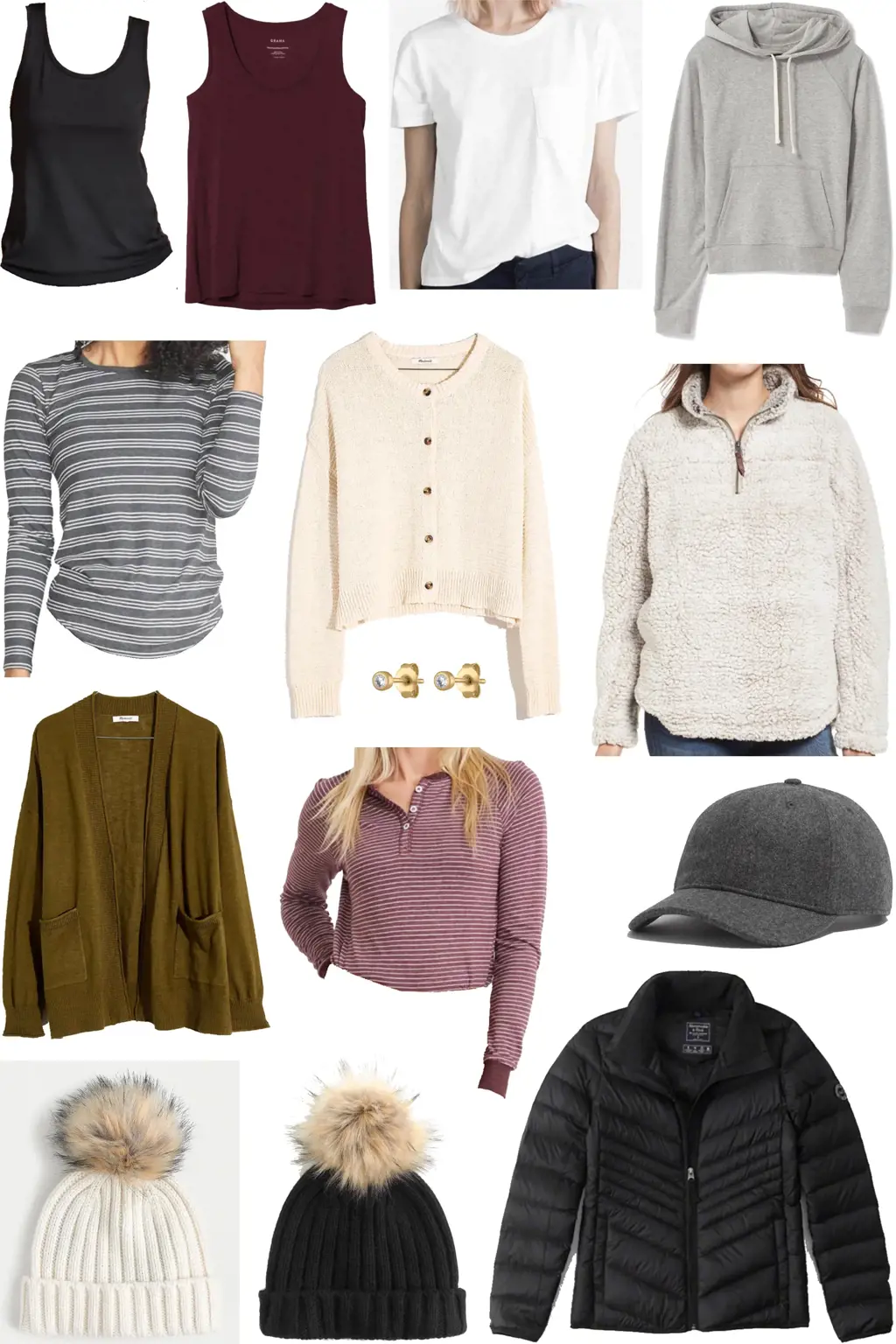
When planning a trip to Yellowstone National Park in September, it is important to pack the right type of clothing to ensure comfort and preparedness for the changing weather conditions. September in Yellowstone can bring a mix of warm and cold temperatures, as well as the possibility of rain and snow. Here are some tips for packing appropriate clothing for a September trip to Yellowstone:
- Layering is key: The weather in Yellowstone can be unpredictable, especially in September. It is essential to pack clothing that can be layered to adjust to changing temperatures throughout the day. Start with a base layer made of moisture-wicking material to keep you dry and comfortable. This can be a long-sleeved shirt and leggings or thermal underwear.
- Mid-layers for warmth: On top of your base layer, pack a mid-layer that can provide insulation when the temperatures drop. This can be a lightweight fleece or a down jacket. This layer should be easy to remove or add as needed.
- Waterproof and windproof outer layer: September in Yellowstone can bring rain and wind, so it is important to have a waterproof and windproof outer layer. A breathable rain jacket with a hood is a good choice to protect you from the elements. Additionally, pack waterproof pants or a skirt to keep your lower body dry.
- Comfortable and sturdy footwear: Yellowstone National Park offers a variety of trails and outdoor activities, so it is essential to pack comfortable and sturdy footwear. Opt for waterproof hiking boots or shoes that provide good support and traction. It is also a good idea to pack a pair of waterproof sandals or water shoes if you plan on participating in water-based activities.
- Hats, gloves, and accessories: Don't forget to pack a hat to protect your head from the sun and keep you warm in colder temperatures. Gloves are also important to keep your hands warm during chilly mornings or evening outings. Sunglasses with UV protection are necessary to shield your eyes from the sun's harmful rays. Finally, bring a buff or scarf that can be used as a face mask, neck warmer, or headband depending on the weather conditions.
- Other essentials: Besides clothing, there are a few other essentials to pack for a September trip to Yellowstone. Consider packing a lightweight and packable backpack for day trips and hikes. This will allow you to carry extra layers, snacks, and water. Additionally, bring insect repellent to protect yourself from mosquitoes and other bugs that may still be present in September.
By packing the right type of clothing for a September trip to Yellowstone National Park, you can ensure comfort and be prepared for the changing weather conditions. Layering your clothing, bringing waterproof and windproof outer layers, and wearing comfortable footwear will allow you to enjoy your outdoor adventures while staying dry and warm. Don't forget to pack the necessary accessories such as hats, gloves, and sunglasses to protect yourself from the sun and cold temperatures. With the right clothing and gear, you can fully enjoy the beauty and wonders of Yellowstone National Park in September.
Essential Packing List for an Unforgettable Antarctica Cruise Adventure
You may want to see also

Are there any specific items or equipment that I should bring for outdoor activities in Yellowstone in September?
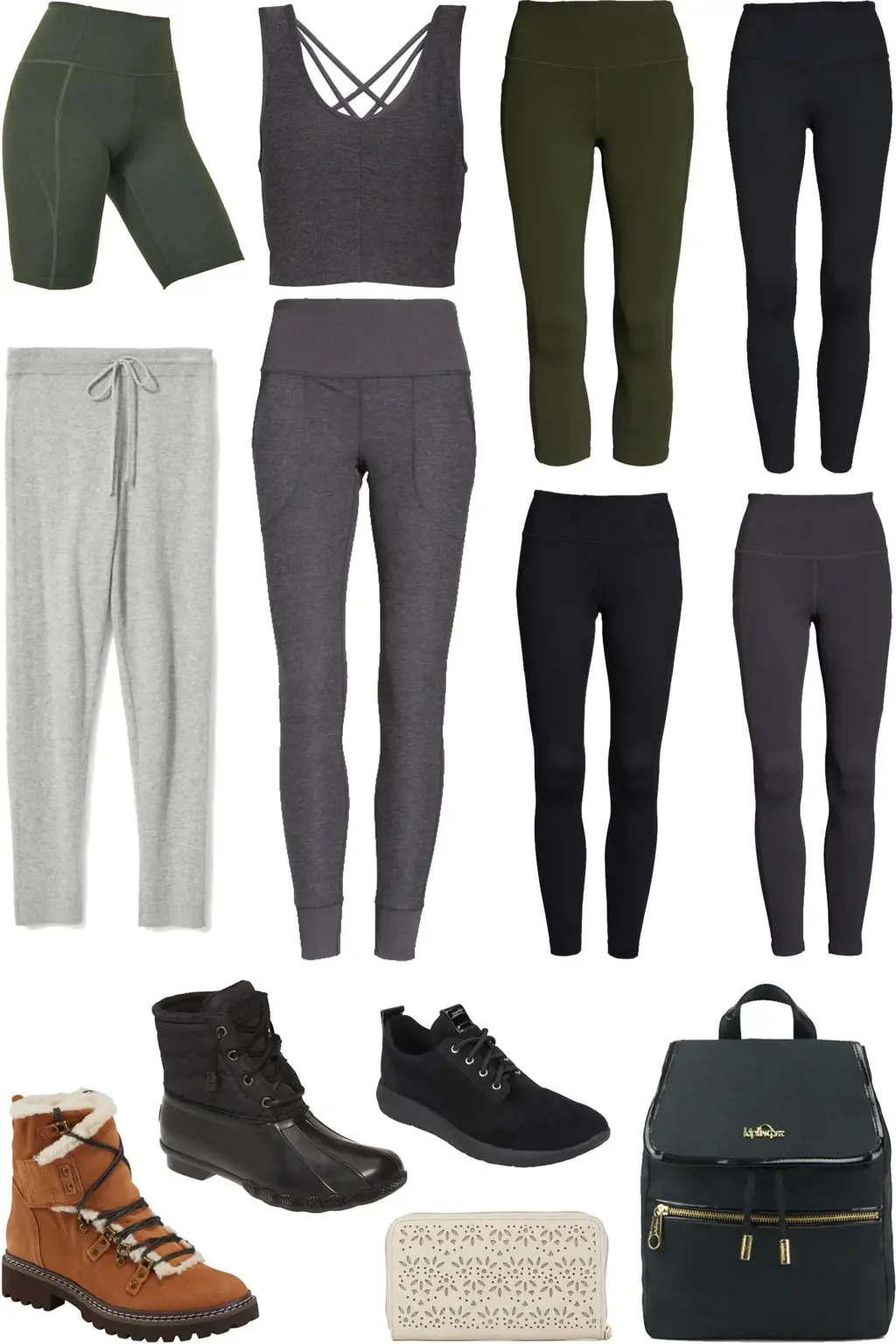
Yellowstone National Park is a stunning destination for outdoor enthusiasts. With its diverse landscapes and abundant wildlife, it offers countless opportunities for hiking, camping, wildlife watching, and other outdoor activities. If you're planning a trip to Yellowstone in September, there are a few specific items and equipment that you should consider bringing to make the most of your outdoor adventures.
- Layered clothing: September in Yellowstone can bring unpredictable weather, with daytime temperatures ranging from chilly mornings to warm afternoons. It's important to bring layered clothing to adjust to changing conditions. This might include a warm base layer, a fleece or down jacket for insulation, and a waterproof outer layer to protect you from rain or snow.
- Sturdy hiking boots: Yellowstone has a vast network of hiking trails that showcase its breathtaking scenery. A pair of sturdy hiking boots is essential for exploring the park's diverse landscapes, including geothermal areas, forests, and canyons. Make sure your boots are comfortable and provide good support for your feet and ankles.
- Binoculars: Yellowstone is home to a wide variety of wildlife, including bears, wolves, elk, and bison. To get a closer look at these magnificent creatures without disturbing them, bring a pair of binoculars. This will allow you to observe wildlife from a safe distance and appreciate their natural behavior.
- Insect repellent: September can still have mosquitoes and other biting insects in Yellowstone. To protect yourself from itchy bites and potential diseases, bring a good-quality insect repellent. Look for a product that contains DEET or picaridin, as these are the most effective ingredients for repelling mosquitoes and ticks.
- Sun protection: Although the temperatures might be cooler in September, the sun can still be strong at higher altitudes, especially in areas with thin air. It's important to bring sun protection, including a wide-brimmed hat, sunglasses, and sunscreen with a high SPF. This will help protect your skin and eyes from the sun's harmful rays.
- Bear spray: Yellowstone is home to both black bears and grizzly bears, and encounters with these animals can happen, especially when hiking in remote areas. It's crucial to carry bear spray as a safety precaution. Bear spray is a form of pepper spray specifically designed to deter bears and can be effective in protecting yourself in a bear encounter.
- Water and snacks: Exploring Yellowstone's vast landscapes can be physically demanding, so it's essential to stay hydrated and energized. Bring a refillable water bottle and pack plenty of snacks to fuel your adventures. Trail mix, energy bars, and fresh fruit are lightweight and easy to carry, providing a quick boost of energy on the go.
- Maps and guidebooks: While the park has well-maintained trails, it's always a good idea to have a map or guidebook with you. These resources can help you navigate the park's different attractions, highlight points of interest, and provide information about wildlife and safety precautions.
- Camera: Yellowstone is a photographer's paradise, with stunning landscapes, unique geothermal features, and majestic wildlife. Don't forget to bring your camera or smartphone to capture the beauty of the park. Make sure to have extra batteries or a charger to keep your devices powered throughout your adventures.
By packing these essential items and equipment, you'll be well-prepared to enjoy all that Yellowstone National Park has to offer in September. Remember to always prioritize safety and respect for the park's wildlife and natural resources. With the right gear and a sense of adventure, you're bound to have an unforgettable experience in this iconic national park.
Essential Packing Guide for a Disney Alaska Cruise: What to Bring for an Unforgettable Voyage
You may want to see also

Will I need to pack any special gear for hiking or camping in Yellowstone in September?
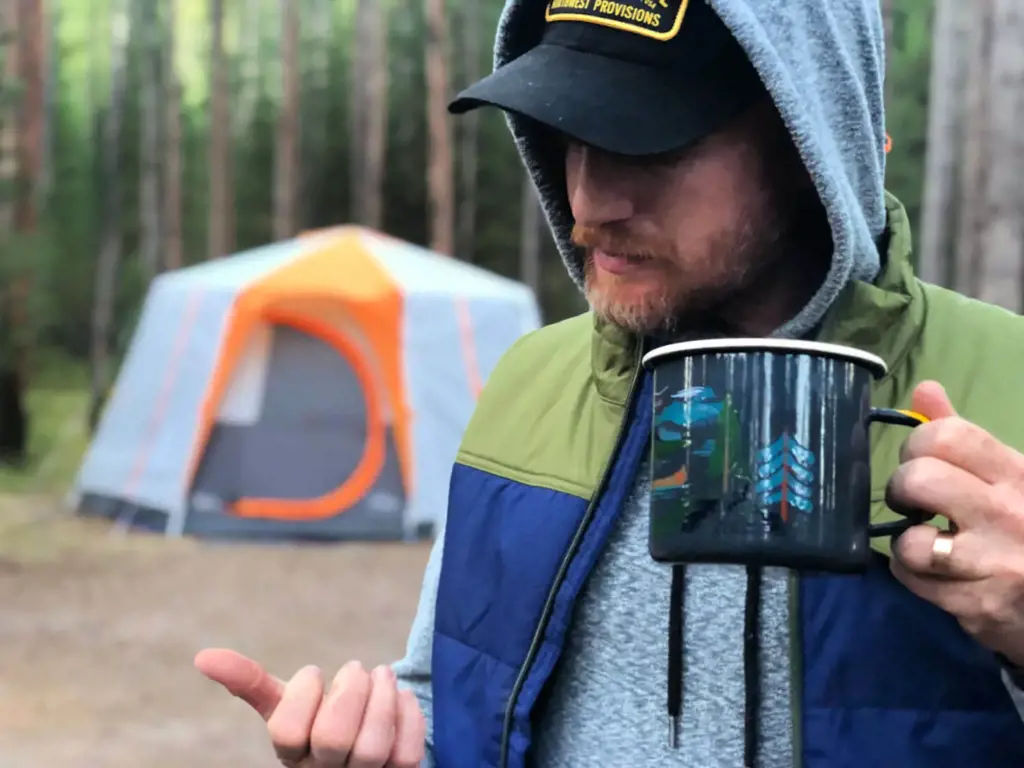
If you are planning a trip to Yellowstone National Park in September, it is important to pack the right gear to ensure a successful and enjoyable hiking or camping experience. While the weather in September can be unpredictable, with changing temperatures and the possibility of snowfall, being prepared with the proper gear is essential.
First and foremost, it is important to have a sturdy and comfortable pair of hiking boots. Yellowstone offers a variety of hiking trails with different levels of difficulty, so having proper footwear is crucial for stability and comfort. Make sure your boots are waterproof and have good traction to navigate the potentially wet and muddy trails.
In addition to hiking boots, it is also important to have appropriate clothing layers. September in Yellowstone can see a wide range of temperatures, with chilly mornings and evenings and potentially warmer afternoons. It is recommended to dress in layers, so you can easily adjust your clothing depending on the weather. Start with a moisture-wicking base layer, followed by a warm insulating layer, and top it off with a waterproof and windproof outer layer. Don't forget to pack a hat and gloves for added warmth when needed.
Another essential item to pack is a good quality backpack. Whether you are planning a day hike or an overnight camping trip, a backpack is essential for carrying your gear and supplies. Look for a backpack with enough capacity to hold all your essentials, and make sure it is comfortable to wear for extended periods of time.
For longer hiking or camping trips, it is important to have reliable camping gear. This includes a sturdy tent, sleeping bag, and sleeping pad. September in Yellowstone can bring cold nights, so make sure your sleeping bag is rated for the expected temperatures. Also, consider bringing a camping stove and cookware if you plan on cooking your meals in the backcountry.
Safety should always be a priority when hiking or camping in Yellowstone. It is important to have a map and compass or a GPS device to help navigate the trails and avoid getting lost. Additionally, pack a first aid kit, a headlamp or flashlight, and a whistle for emergencies. Bear spray is also essential, as Yellowstone is home to grizzly bears and encounters can occur. Make sure you know how to use bear spray properly before your trip.
Finally, pack plenty of water and high-energy snacks to keep yourself hydrated and nourished during your adventure. Yellowstone has limited amenities and it is important to be self-sufficient in terms of food and water.
In conclusion, packing the right gear for hiking or camping in Yellowstone in September is essential for a successful and enjoyable trip. By having sturdy footwear, proper clothing layers, a good quality backpack, reliable camping gear, safety essentials, and enough food and water, you'll be prepared for whatever the park's unpredictable weather and terrain have in store for you.
Essential Items to Pack for a Memorable Summer Trip to Lake Tahoe
You may want to see also

Are there any specific precautions or items I should pack for encountering wildlife in Yellowstone in September?
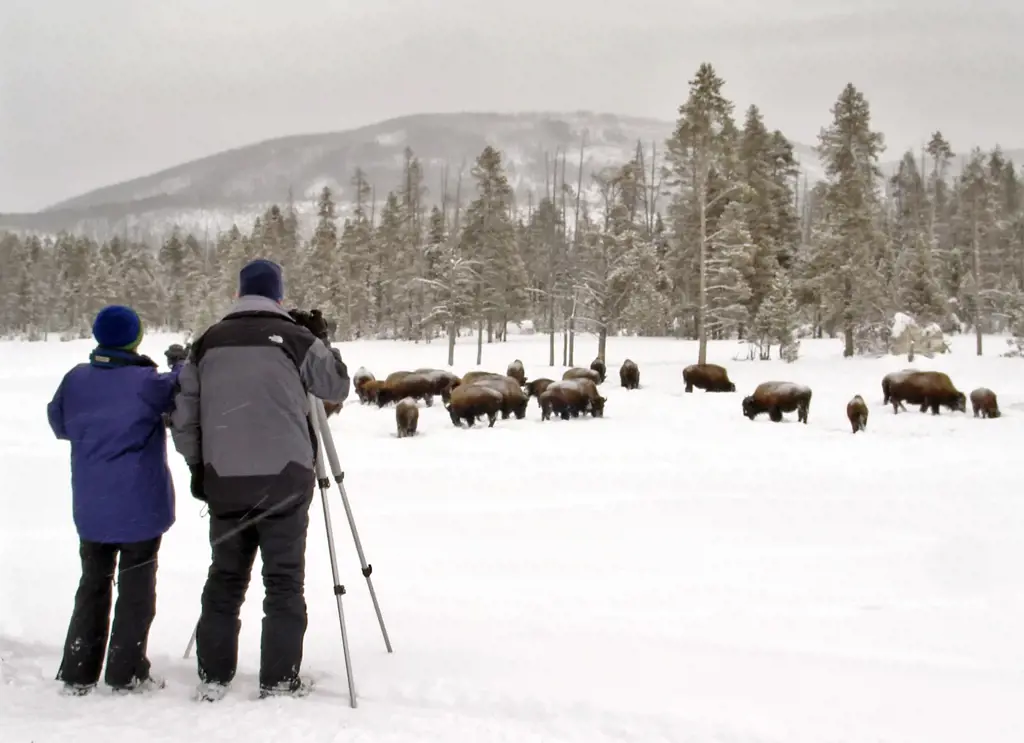
Yellowstone National Park is home to a diverse range of wildlife, including bears, wolves, elk, and bison. September is a beautiful time to visit the park, as the summer crowds begin to diminish and the autumn colors start to appear. However, it is important to take precautions and be prepared when encountering wildlife in the park.
First and foremost, it is essential to remember that Yellowstone is a wild and untamed place. Animals roam freely throughout the park, and it is important to maintain a safe distance and respect their space. Park regulations state that visitors must stay at least 100 yards away from bears and wolves and 25 yards away from all other wildlife. Approaching too closely can be dangerous for both you and the animal.
When hiking or exploring the park, it is a good idea to make noise to alert wildlife of your presence. This can be as simple as talking loudly or clapping your hands. Most wildlife will generally move away from human activity if they hear you coming. It is also recommended to travel in groups, as larger groups are less likely to surprise wildlife than individuals.
In terms of items to pack, there are a few essentials to consider. Binoculars are a great tool for observing wildlife from a safe distance, allowing you to get a closer look without getting too close. A good camera can also be handy for capturing memories of your wildlife encounters. However, it is important not to get too focused on capturing the perfect shot and to always prioritize your safety and the well-being of the animals.
In addition to observing wildlife from a distance, it is also important to store your food properly to prevent attracting animals to your campsite. This includes using bear-resistant food storage containers, hanging food from a tree branch, or using designated food storage lockers. These measures help to keep both you and the animals safe, as feeding wildlife can alter their natural behaviors and create potentially dangerous situations.
If you do encounter wildlife while in Yellowstone, it is important to stay calm and avoid sudden movements. Never approach or attempt to feed the animals. Instead, give them plenty of space and slowly back away. In the rare event that you find yourself charged by a bear or mountain lion, make yourself look larger by raising your arms or opening your jacket and slowly back away without turning your back to the animal. It is important to familiarize yourself with the park's guidelines for encounters with specific species, as each animal may require a slightly different approach.
Ultimately, encountering wildlife in Yellowstone can be an incredible and memorable experience. By taking precautions, maintaining a safe distance, and respecting their space, you can enjoy the beauty of Yellowstone's wildlife while ensuring your own safety and the well-being of the animals. So pack your binoculars, camera, and a sense of adventure and get ready to explore the wonders of Yellowstone National Park.
Essential Items to Pack for a Successful Tummy Tuck Surgery
You may want to see also

What are some essential items that I should include in my packing list for a September trip to Yellowstone National Park?
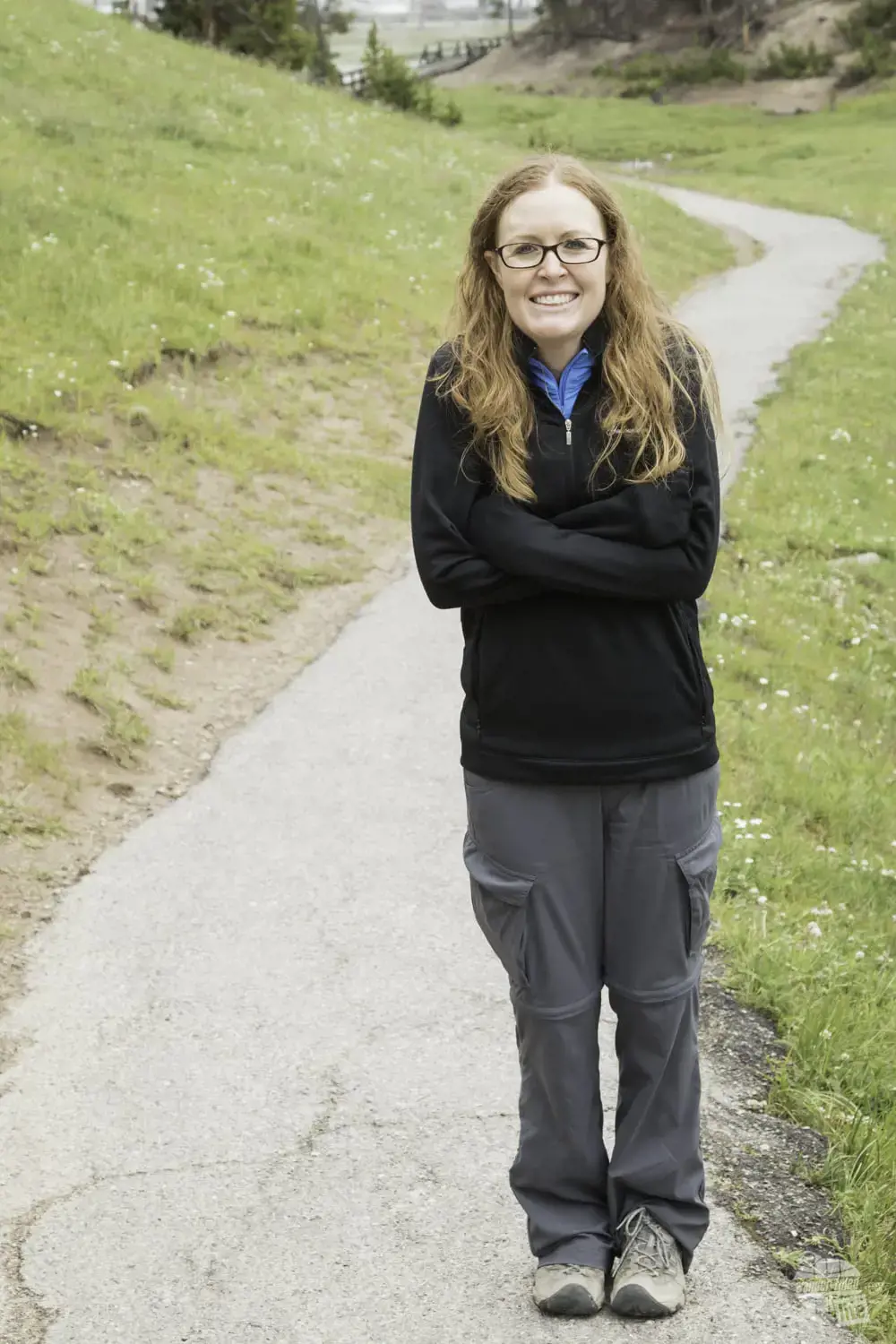
As you prepare for your September trip to Yellowstone National Park, it's important to pack the right essentials to ensure a comfortable and enjoyable experience. September can be a transitional month in Yellowstone, with changing weather and the start of the fall season. Here are some essential items to include in your packing list for a September trip to Yellowstone National Park:
- Clothing Layers: September weather in Yellowstone can be unpredictable, with daytime temperatures ranging from 50 to 70 degrees Fahrenheit and nighttime temperatures dropping into the 30s or 40s. It is essential to pack clothing layers that can be easily added or removed to adjust to the changing temperatures. Include items such as long-sleeve shirts, lightweight jackets, sweaters or fleece, and a waterproof outer layer to protect against rain or snow.
- Hiking Boots: Yellowstone is known for its stunning natural landscapes and hiking trails. Make sure to pack a sturdy pair of hiking boots that provide good ankle support and are comfortable for long walks. Additionally, consider bringing extra pairs of socks to keep your feet dry and blister-free.
- Binoculars and Camera: Yellowstone is a haven for wildlife enthusiasts and photographers. Binoculars will allow you to observe wildlife from a distance, while a camera will help you capture the beauty of the park. Don't forget to pack extra batteries and memory cards to ensure you don't miss out on any amazing photo opportunities.
- Insect Repellent: While September is generally less buggy than the summer months, there may still be some mosquitos and other insects in the park. Pack a good-quality insect repellent to protect yourself from bites. Additionally, consider bringing a hat and lightweight long-sleeve shirts and pants to further protect against insect bites and sun exposure.
- Sun Protection: Even in September, the sun can be intense at high altitudes. Pack sunscreen with a high SPF rating to protect your skin from harmful UV rays. Don't forget to pack sunglasses and a wide-brimmed hat to shield your face and eyes from the sun.
- Snacks and Water: Yellowstone National Park is vast, and it can take several hours to drive between different areas of the park. Pack plenty of water and snacks to keep yourself hydrated and energized throughout the day. Consider packing easy-to-carry items such as granola bars, trail mix, and fruits.
- Maps and Guidebooks: While Yellowstone has excellent signposting, it's always a good idea to have a map or guidebook with you to navigate the park and learn about its history and attractions. These resources can also help you identify points of interest and plan your itinerary.
- First Aid Kit: Accidents and minor injuries can happen, so it's important to have a basic first aid kit with you. Include items such as adhesive bandages, antiseptic ointment, pain relievers, and any personal medications you may need.
Remember to check the weather forecast for Yellowstone before your trip and adjust your packing list accordingly. By including these essential items, you'll be well-prepared to experience the beauty and natural wonders of Yellowstone National Park in September.
Essential Items to Pack for a Trip to Japan in April
You may want to see also
Frequently asked questions
In September, the weather in Yellowstone can be quite temperamental. It's important to pack a variety of clothing options to be prepared. Layers are key, so bring a mix of t-shirts, long-sleeved shirts, sweaters, and a lightweight jacket or fleece. Don't forget to pack a waterproof and windproof outer layer, as well as a warm hat and gloves for cooler mornings and evenings.
Yes, bringing hiking boots is highly recommended for exploring Yellowstone in September. The terrain can be rugged and uneven, especially on the hiking trails. Hiking boots with good ankle support and traction will help keep you comfortable and safe while exploring the park.
Yes, packing sunscreen is essential for visiting Yellowstone in September. Even though the temperatures may be cooler, the sun's rays can still be strong at higher elevations. Make sure to apply sunscreen generously to protect your skin from harmful UV rays, especially when spending time outdoors.
Mosquitoes and other biting insects can still be present in Yellowstone in September, so it's a good idea to bring insect repellent. Look for a repellent that contains DEET or picaridin to effectively ward off bugs. It's also a good idea to have a mosquito head net as an extra precaution, especially if you plan on spending time near bodies of water.
Wildlife is abundant in Yellowstone, and September can be a great time to spot animals as they prepare for winter. It's a good idea to bring binoculars to help you get a closer look at the wildlife from a safe distance. Additionally, a telephoto lens for your camera can come in handy for capturing memorable wildlife shots. Remember to always maintain a safe distance and never approach or disturb the animals.


